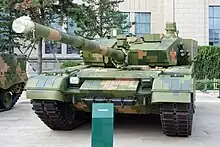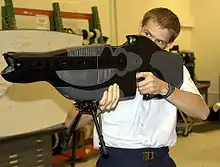Dazzler (weapon)
A dazzler is a non-lethal weapon which uses intense directed radiation to temporarily disorient its target with flash blindness. They can effectively deter further advances, regardless of language or cultural barriers, but can also be used for hailing and warning.[1] Targets can include electronic sensors as well as human vision.[2]

Initially developed for military use, non-military products are becoming available for use in law enforcement and security.[3][4]
Design
Dazzlers emit infrared light against various electronic sensors and visible light against humans. They are intended not to cause long-term damage to eyes. The emitters are usually lasers, making what is termed a laser dazzler. Most of the contemporary systems can be carried by a person, and operate in either the red (a laser diode) or green (a diode-pumped solid-state laser, DPSS) areas of the electromagnetic spectrum. The green laser is chosen for its unique ability to react with the human eye.[5] Dazzlers maintain eye safety by producing diverging light that is less coherent (focused) than typical lasers. This produces a larger, less concentrated spot at greater distances which is easier to aim at longer distances and retains the desired effect on targets.[6]
History
Some searchlights are bright enough to cause permanent or temporary blindness, and they were used to dazzle the crews of bombers during World War II. Whirling Spray was a system of search lights fitted with rotating mirrors which was used to dazzle and confuse pilots attacking the Suez canal.[7] This was developed into the Canal Defence Light, a small mobile tank mounted system intended for use in the Rhine crossings. However, the system was mainly used as conventional searchlights.
Handgun or rifle-mounted lights may also be used to temporarily blind an opponent and are sometimes marketed for that purpose. In both cases the primary purpose is to illuminate the target and their use to disorient is secondary.
The first reported use of laser dazzlers in combat was possibly by the British, during the Falklands War of 1982, when they were reputedly fitted to various Royal Navy warships to hinder low-level Argentinian air attacks.[8][9] However, Michael Heseltine, the UK's Secretary of State for Defence immediately after the conflict, stated that whilst the dazzlers had been deployed they were not used.[10]
At the end of Operation Desert Storm, F-15E crews observed the Iraqi military's massacre of Kurdish civilians at Chamchamal. The pilots were forbidden from firing on the Iraqi soldiers and instead used their lasers as dazzlers against the enemy helicopter pilots. This ultimately proved ineffective in crashing any attack helicopters.[11]
On 18 May 2006, the U.S. military announced it was using laser dazzlers mounted on M4 rifles in troops in Iraq as a non-lethal way to stop drivers who fail to stop at checkpoints manned by American soldiers.[12] Other militaries have taken up use of them as well.[13]
Countermeasures
One defense against laser dazzlers are narrowband optical filters tuned to the frequency of the laser. To counter such defense, dazzlers can employ emitters using more than one wavelength, or tunable lasers with wider range of output.[14] Another defense is photochromic materials able to become opaque under high light energy densities. Nonlinear optics techniques are being investigated: e.g. vanadium-doped zinc telluride (V:ZnTe) can be used to form electro-optic power limiters able to selectively block the intense dazzler beam without affecting weaker light from an observed scene.
Legislation

Weapons designed to cause permanent blindness are banned by the 1995 United Nations Protocol on Blinding Laser Weapons. Dazzlers intended to cause temporary blindness or disorientation fall outside this protocol.
Manufacturers and models
- LE Systems, under the sponsorship of DARPA, developed a dazzler based on a DPSS laser, with green light output at 532 nm, essentially a higher-intensity version of a green laser pointer. 532 nm light interacts with human eyes well in both daylight and reduced light conditions.[5]
- B.E. Meyers & Co. produces several dazzlers including the GLARE LA-9/P, GLARE MOUT, GLARE RECOIL LA-22/U, and GLARE HELIOS. The GLARE RECOIL and GLARE HELIOS dazzlers utilize built-in safety mechanisms to prevent eye damage by pairing the dazzler with a rangefinder; the dazzler will self-modulate power output with respect to range to target so the closer the target, the lower the output and the farther the target, the greater the output. As a result the maximum safe laser intensity output is utilized without risking ocular damage.[15][16][17] The older GLARE LA-9/P variant includes a rangefinder and an automatic cutoff failsafe but does not have automated modulation capability.[18] Effective range for the various GLARE dazzlers ranges from 400m to 20+km. Despite having the greatest effective range of 5-25+km, the GLARE HELIOS is classified as an FDA Laser safety#Class 1M eye-safe laser.[19][20][16][15]
- The Dazer Laser Guardian, Dazer Laser Stealth, and "Dazer Laser Defender" by Laser Energetics, Inc. are different types of optical distraction laser systems which can temporarily visually impair, illuminate, target designate, warn and/or communicate visually with the intended target.
- The Saber 203 dazzler is a grenade launcher based system. It is similar to the LANL-developed optical munition, Project Perseus. The dazzler is launched from a standard 40mm grenade launcher and activated via a control switch to induce glare. The U.S. Marine Corps brought Saber 203 dazzlers to Somalia in January 1995 during Operation United Shield, but senior U.S. Department of Defense officials reportedly halted its experimental use at the last minute for "humane reasons".[21] According to the Air Force, the Saber 203 system is also usable for law enforcement purposes.[2]
- The JD-3 laser dazzler is mounted on the Chinese Type 98 main battle tank. It is coupled with a laser radiation detector, and serves as a countermeasure by automatically aiming at any enemy's illuminating laser designator, attempting to overwhelm its optical systems or blind the operator.
- The ZM-87 Portable Laser Disturber is a Chinese electro-optic countermeasure laser device. It can blind enemy troops at up to 2 to 3 km range and temporarily blind them at up to 10 km range. This weapon is banned by the 1995 United Nations Protocol on Blinding Laser Weapons.
- The Photonic Disruptor, classified as a threat assessment laser (TALI), was developed and manufactured by Wicked Lasers in cooperation with Xtreme Alternative Defense Systems. This tactical laser is equipped with a versatile focus-adjustable collimating lens to compensate for range and power intensity when used at close range to incapacitate an attacker, at a distance to safely identify threats. The Photonic Disruptor has been featured on Discovery Channel's "Future Weapons." It was also reportedly used by Sea Shepherd Conservation Society during their operations with the Ady Gil in the Southern Ocean against Japanese whaling.[22]
- The Outfit DEC or Laser Dazzle Sight (LDS) is a British ship-based laser. The veiling-glare laser utilizes ultraviolet light and is designed to dazzle by causing fluorescence in the lens of the human eye. There are other such laser weapon systems in development.[2][23][24][25]

- StunRay is a less-lethal optical incapacitation effector developed by Genesis Illumination Inc. It uses collimated incoherent (non-laser) broad spectrum visible and near infrared light from a short-arc lamp to safely and temporarily impair vision, disorient and incapacitate aggressors for 5 seconds to 3 minutes without causing physical harm. Full recovery generally occurs in 10–20 minutes. The hand-held model is designed for a range of 10m to 100m. StunRay can be scaled up for ranges from 100m to 1000m for vehicle mounting, checkpoints, secure facilities, patrol boats, and ship protection.[26]
- The PHaSR or Personnel halting and stimulation response rifle was developed by the U.S. Department of Defense.
- Three US Patents are held by Science & Engineering Associates (SEA) who is now QinetiQ North America. They are: 5,685,636 Eye Safe Laser Security Device; 6,007,218 Self-Contained Laser Illuminator Module; and 6,190,022 B1 Enhanced Non-Lethal Security Device.
Notes
- Rogoway, Tyler (26 July 2020). "Check Out This Sailor Holding A Laser Rifle Aboard The Nuclear Submarine USS Minnesota". The WarZone. Archived from the original on 14 August 2021. Retrieved 29 June 2022.
- "U.S. Blinding Laser Weapons". Human Rights Watch Report. May 1995. Archived from the original on 19 June 2022., Vol. 7, No. 5
- Mark Harris (27 May 2009). "US cops and military to get laser guns". Techradar.com. Archived from the original on 26 February 2022. Retrieved 28 July 2010.
- Chris Matyszczyk (23 July 2010). "Police to experiment with blinding 'Dazer Laser'?". CNET.com. Archived from the original on 25 October 2012. Retrieved 28 July 2010.
- Kehoe, Jay D. (28 December 1998). "Laser dazzler for nonlethal force applications". Proceedings of the SPIE. 3575 (1998): 26–29. Bibcode:1998SPIE.3575...26K. doi:10.1117/12.335009. S2CID 110765877. Retrieved 29 June 2022.
- Hecht, Jeff (1 April 2013). "PHOTONIC FRONTIERS: NONLETHAL LASERS: Nonlethal lasers deter attacks and warn away noncombatants". Laser Focus World. Archived from the original on 12 November 2020. Retrieved 29 June 2022.
- "Real Lives: Magic at War". Channel 4.
- "Type 22 frigates". Haze Gray & Underway website. Retrieved 22 February 2010.
- "The Buzz 27 January 2003 - Man-made Bolts of Lightning". ABC Radio National. Abc.net.au. 27 January 2003. Retrieved 2008-12-26.
- "UK deployed Falklands 'dazzle' laser, documents show". BBC News. August 2013.
- Davies (2005). "2". Desert Shield and Desert Storm. pp. 30–31.
- "NewsLibrary.com". Nl.newsbank.com. 2006-05-18. Retrieved 2012-08-13.
- Hambling, David (9 August 2010). "British Army uses laser dazzlers to save lives". Wired. Archived from the original on 25 February 2021. Retrieved 29 June 2022.
- Crane, David (17 January 2005). "New Laser Dazzler Technologies for Infantry Warfare, Counterinsurgency Ops, and LE Apps". Defense Review. Archived from the original on 1 March 2022. Retrieved 29 June 2022.
- "GLARE HELIOS". B.E. Meyers & Co. Archived from the original on 19 May 2022. Retrieved 29 June 2022.
- "GLARE RECOIL OCULAR INTERRUPTION SYSTEM". BE Meyers Advanced Photonics. Archived from the original on 19 May 2022. Retrieved 28 June 2022.
- "B.E. Meyers & Co Defense Catalog 2022". B.E. Meyers & Co. p. 50. Archived from the original on 29 June 2022. Retrieved 29 June 2022.
- "GLARE LA-9/P OCULAR INTERRUPTION SYSTEM". BE Meyers & Co. Archived from the original on 19 May 2022. Retrieved 27 June 2022.
- "GLARE MOUT". B.E. Meyers & Co. Archived from the original on 19 May 2022. Retrieved 29 June 2022.
- "GLARE MOUT Plus". B.E. Meyers & Co. Archived from the original on 29 June 2022. Retrieved 29 June 2022.
- Schmitt, Eric (February 15, 1995). "Now, to the Shores of Somalia with Beanbag Guns and Goo". New York Times.
- Hambling, David (15 January 2010). "Whaling Protesters Pioneer Non-Lethal Warfare". Wired, Danger Room.
- "Company Search: Irwin Desman". Parasitic Protocol Portfolio. Archived from the original on 2007-02-20.
- "dead link". Archived from the original on 2001-07-24.
- "dead link". Archived from the original on 2007-09-27.
- "StunRay Non-Lethal Technology". Genesis-illumination.com. Archived from the original on 27 June 2013. Retrieved 2012-12-05.
References
- Lisa A. Small, Blinding Laser Weapons: It is Time for the International Community to Take Off Its Blinders, online ICLTD INC.
- Louise Doswald-Beck, 30.06.1996, New Protocol on Blinding Laser Weapons, International Review of the Red Cross Nr. 312, S.272–299, online International Review of the Red Cross
- Burrus M. Carnahan, Marjorie Robertson, The American Journal of International Law, The Protocol on "Blinding Laser Weapons": A New Direction for International Humanitarian Law, Vol. 90, Nr. 3 (Juli 1996), Pages 484–490.
- Bradford Non-Lethal Weapons Research Project, December 2006 Occasional Paper, No.1: The Early History of "Non-Lethal" Weapons, online University of Bradford (PDF)
